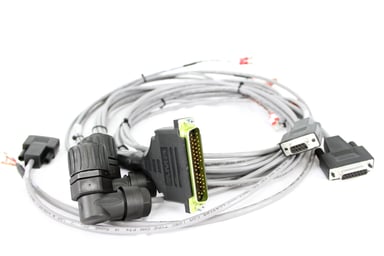 With all the variables involved in designing an electric cable assembly or wiring harness, many times cost effectiveness and ease of manufacture are not at the top of the engineering checklist. In today’s ever more competitive market, where competition and customer demand is putting constant pressure on profit margins, even contract manufacturers in low cost regions are adversely affected by a cable assembly that is not optimized for manufacturability. And this adverse effect more often than not will result in a higher cost, less reliable assembly.
With all the variables involved in designing an electric cable assembly or wiring harness, many times cost effectiveness and ease of manufacture are not at the top of the engineering checklist. In today’s ever more competitive market, where competition and customer demand is putting constant pressure on profit margins, even contract manufacturers in low cost regions are adversely affected by a cable assembly that is not optimized for manufacturability. And this adverse effect more often than not will result in a higher cost, less reliable assembly.
Once the basic specifications are established, issues such as types of wire and connectors, use of jacketing and shielding, types and placement of cable ties and labels, and overall tolerances play an important role in determining the material costs, manufacturing costs and long term reliability of an assembly.
Much of today’s cable and harness work that has not moved to Asia are low volume, high mix assemblies that might not lend themselves to high volume automation. Many U.S. based cable assembly houses find themselves building small lot quantities in many variations. In many cases the cost of automating production of these lower volumes is prohibitive. The result is a high unit labor content than might would be the case for larger production volumes. This means that giving due consideration to the manufacturability of an assembly is as important as ever.
With this in mind, below are a few items that if not considered carefully can add unnecessary cost and complexity to a cable assembly or wiring harness.
- Teflon vs. PVC Wire Insulation. Does the design really require Teflon when PVC will do? Not only is PVC insulted wire less expensive, it is also easier to work with in the manufacturing process.
- Soldering vs. Crimped Contacts. Soldered connections require a much higher degree of operator training and labor time and, as a result, are much more expensive than crimped contacts.
- Jacketing and Shielding. What type of external protection (if any) does the assembly require? Specifying a shrink tube or braided loom might require terminals and connectors to be installed after the shielding. This would require additional hand labor which, of course, adds cost.
- Fixation (tie wraps). How many and what type of tie wrap does the assembly require? Tie wrap pricing varies widely from manufacturer to manufacturer and each takes labor to apply. The more tie wraps specified, the higher cost.
- Labels. Labels may be one of the most overlooked cost driver in cable assemblies and harnesses. First, the cost of labels varies wildly based on the type specified. Wrap around labels are fairly inexpensive while cost of shrink labels is much higher. But the cost of the labels may be small relative to the cost of applying them. In complex assemblies properly locating each wire and the position of the label on it can be labor intensive.
- Tolerances. If labels are one of the most overlooked cost drivers then excessively tight tolerances might be the most unnecessary. All too often design engineers will take the “safe” path of using tight tolerances on cable assembly designs. Unlike many mechanical parts most cable assemblies are flexible which generally means that tight tolerances are unnecessary. Contract manufactures can meet most tolerances but the tighter they are, the more difficult the assembly becomes to manufacture, the more expensive the assembly becomes.
These are just a few things to consider when designing a cable assembly or harness. Even better is to work with an experienced assembly manufacturer as early on in the design process as possible.
About the Authors
 Fred Morr is Senior Operations Manager of RESCO Electronics in Acuna, Mexico, a manufacturer of electronic assemblies and value added reseller of auto ID equipment to original equipment manufacturers. Before joining RESCO in 2011, Fred owned and operated his own company MorrCo Enterprises LLC in Del Rio, TX/Acuna, Mexico, an organization specializing in contract assembly of PCB’s, cables and harnesses and was sold to RESCO Electronics in 2011.
Fred Morr is Senior Operations Manager of RESCO Electronics in Acuna, Mexico, a manufacturer of electronic assemblies and value added reseller of auto ID equipment to original equipment manufacturers. Before joining RESCO in 2011, Fred owned and operated his own company MorrCo Enterprises LLC in Del Rio, TX/Acuna, Mexico, an organization specializing in contract assembly of PCB’s, cables and harnesses and was sold to RESCO Electronics in 2011.
From 2001 to 2004, Fred was General Operations Manager of Sample Group South LLC in Del Rio, TX/Acuna Mexico, a company that manufactures books/cards for the textile and vinyl wall covering industry where he helped build a Mexican corporation and ensured compliance with NAFTA regulations for all US customs transactions. He was also the President of NAFTA, Inc. in Del Rio, TX/Acuna, Mexico from 1997-2001 where he helped them achieve ISO 9002 Certification for Fiber Optic Cable Assembly and restructured the company profile from consignment to turnkey supplier.
Fred studied at the University of Texas, has taken numerous professional training courses, and is fluent in English, Spanish and German. He is married and lives in Del Rio, TX with his wife and children.
Juan P. Garza is the Plant Manager of RESCO Electronics Mexican Division, a manufacturer of electronic assemblies and a value added reseller of auto ID equipment.
JP has over 30 years of experience in electronics manufacturing, with emphasis in cable and harness assembly. Before joining RESCO in 2011, JP was the Plant Manager of MorrCo/NAFTA, a cable and harness contract manufacturer. He has vast experience in ISO quality systems and data base programing.
At ITESM campus Monterrey Mexico, JP has a Bachelor of Science in Computer Systems. He also holds a MIT for IPC-610, IPC-620 and J-STD.


